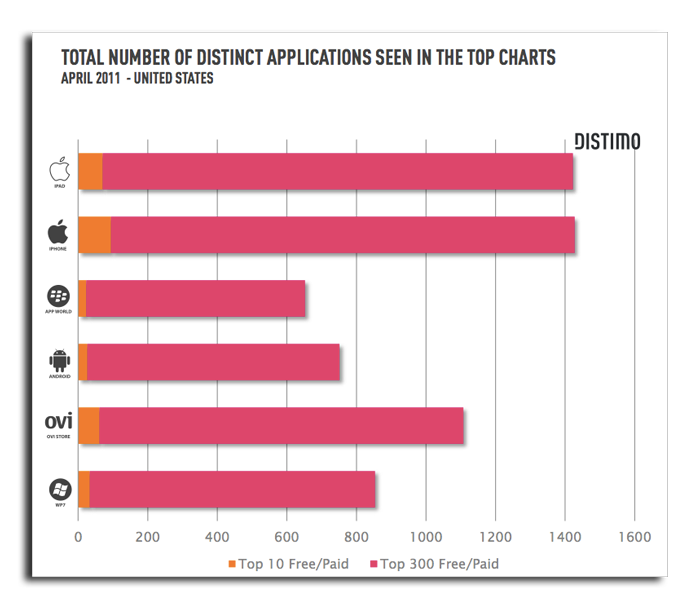Paid apps find success much easier on Apple's iPhone than Google Android
Analytics firm Distimo on Friday issued a new report offering an "in-depth view on download volumes in the Google Android Market." The results show that reaching sales of more than a half-million for paid applications on Android is extremely difficult.
Distimo found that only two paid applications in the Android market have been downloaded more than 500,000 times worldwide in the history of the digital storefront. For comparison, six paid applications available on the App Store reached 500,000 in the U.S. alone in just a two month span.
Even when the numbers are reduced to 250,000, it still shows Apple with a clear advantage. Looking at just games, Distimo found that there are five paid games in the Android market with more than a quarter-million sales worldwide. For the iPhone, ten paid games reached 250,000 downloads in the U.S. alone in two months.
The study also found that the "refresh rate" of paid software in the top 10 is much higher on the iPhone App Store than it is in the Android market. During the month of April, 94 distinct paid applications appeared in the top 10 total downloads, while only 26 distinct paid applications reached the overall top 10 in the Android market.
The data further confirms comments made earlier this year by an Android platform manager at Google. Eric Chu told developers in January that Google is "not happy" about the limited number of mobile applications actually being purchased from the Android Market.
The new numbers show that sales of mobile applications on Apple's iOS platform remain well ahead of the competition, even though the collective sum of Android devices has been outpacing Apple's limited number of hardware options for some time now. In April, the NPD Group revealed that Android devices accounted for 50 percent of U.S. smartphone sales, while the iPhone and iOS accounted for 28 percent of smartphones sold domestically.
 Slash Lane
Slash Lane














 Amber Neely
Amber Neely
 Thomas Sibilly
Thomas Sibilly
 AppleInsider Staff
AppleInsider Staff
 William Gallagher
William Gallagher
 Malcolm Owen
Malcolm Owen
 Christine McKee
Christine McKee










51 Comments
Of course it is. People who use Android (in general) usually want things free. Plus the paid android market isn't available worldwide. Only some countries offer a paid market. I do think the drawback of the app store is the race to the bottom in sales price. I think some apps are more deserving than 99 cents, but since that's stuck in buyers heads a great price, it's a bit unfortunate.
I'll give angry birds as an example. That game has a huge following, gets regular updates that add many levels. I think it should cost more than 99 cents. More like 4 bucks.
Perhaps Google's strategy for unseating iOS was to enter the market at the bottom, sell a lot more cheaper devices, become the dominant platform by sheer numbers, forcing devs to shift to them.
Looks good on paper.
But what if people at the low end of the market buy hardly any apps? Will devs still shift? Lol. Strategy fail.
Perhaps Google's strategy for unseating iOS was to enter the market at the bottom, sell a lot more cheaper devices, become the dominant platform by sheer numbers, forcing devs to shift to them.
Looks good on paper.
But what if people at the low end of the market buy hardly any apps? Will devs still shift? Lol. Strategy fail.
Google used the MS strategy. Flood the market with a lot of junk. Whore out the OS to anyone and everyone.
It'll create big share numbers, along with headaches, user frustration, and an inconsistent experience.
as far as I'm concerned, they can have the market share crown in that case. Keep it.
Anyone who respects their OS - actually cares about what they've created, DOES NOT license universally. Period.
Of course, devs still prefer iOS. Because it seems that people actually like to get paid for their work.
There should be another category beyond free and paid, that being "free" (or perhaps "free-ish") AKA "ad subsidized."
Which fits right in with Google's business model. If consumers will tolerate it, an Android market with nothing but ad supported apps would be just fine, especially if those ads are using Google's metrics.
Google World: everything is "free" as long as you don't mind having everything with an ad attached and contributing to the endlessly refined real time virtual persona that resides on Google's servers. Or as their former CEO would have it, they can "tell you what you want to do next" because they can "more or less know what you're thinking about."
1) …but but but Google is activating 400,000 Android devices per day.
2) Why is iPad and iPhone broken into separate categories, but not Android smartphone and tablet? Are there no apps for Honeycomb? What does that say for those wanting to buy an Android-based tablet?
3) Maybe some will take note of what can happen when you build well instead of trying to build fast.